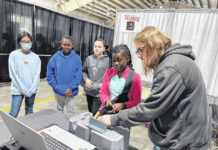LUMBERTON — It seems the counting of ballots from the Nov. 3 general election hasn’t come to an end for the staff at the Robeson County Board of Elections.
The local election workers finished counting the local votes just after midnight Tuesday, tabulating the last provisional and extended supplemental absentee ballots. Now they must participate in a statewide recount of the more than five million votes cast in the race for chief justice of the North Carolina Supreme Court.
Democrat incumbent Chief Justice Cheri Beasley requested the recount in a letter to the State Board of Elections on Tuesday. Beasley trails Republican Paul Newby by fewer than 400 votes out of nearly 5.4 million cast in the race for the state’s highest court. That puts the race within the 10,000-vote threshold for the trailing candidate to demand a recount.
The recount likely will take several days in some counties, and county boards of elections must complete their recounts by Nov. 25, according to the state Elections Board. It is North Carolina’s first statewide recount since the 2016 state auditor’s race, which confirmed the results in that contest.
“We cannot express enough gratitude for the hard work of our county boards of elections, who continue to ensure accurate and fair results in this election,” said Karen Brinson Bell, executive director of the State Board of Elections. “Recounts are an important part of the elections process that help guarantee voters’ wishes are realized in the closest of contests.”
County boards of elections may begin recounting ballots on Thursday or sooner if they meet the 48-hour public notice requirement, according to the NCSBE. All 100 county boards of elections will conduct recounts of their ballots. The counties are responsible for recount costs.
As Robeson County’s numbers, nothing changed except the vote totals as the result of a canvass of votes cast that finally came to and end Tuesday, 14 days after the Nov. 3 general election.
The candidates declared winners late on Nov. 3 remained the victors, according to information provided by the county Elections Board and posted Tuesday on the State Board of Elections website. The county’s count must now be certified by the state board.
The only thing that made the count a bit more interesting for election observers was a reporting mistake that involved 1,951 early voting ballots.
The Robeson County Board of Elections was made aware Saturday of missing information from results collected at the Pembroke Fire Department one-stop site after a State Board of Elections official compared voter history to ballots cast, said Tina Bledsoe, county Board of Elections director. The site was missed by mistake, after the memory card from the tabulator machine was not taken out of the machine at the site that was an addition this year to the usual one-stop site at the library.
“No ballots have been found, no ballots have been missing,” she said.
The county BOE had the machine on-site, and saved information for review at the canvass at 1:30 p.m. Monday upon discovery of the mistake, Bledsoe said.
“All ballots were tabulated for each one-stop site in Robeson County and the results tapes were printed. However, the results data for the Pembroke Fire Department one-stop early voting sites was inadvertently not uploaded to the state’s results database and therefore not reported with the rest of the one-stop early voting results on election night,” according to the State Board of Elections.
The county board was to print a new results tape Monday to verify that the results have not changed since Election Day and then add the results to the overall one-stop early voting total, according to the NCSBE.
“We’ve checked off every Election Day precinct so now we’re going to check off every one-stop site as its loaded,” Bledsoe said Monday.
There also were about 700 provisional ballots and 30 absentee ballots to be added Monday, according NCSBE.
The mistake did not go unnoticed by county political party leaders.
“Our understanding was that when the local BOE submitted their EV numbers that the state board discovered they had ‘missed’ reporting the EV totals from one of the Pembroke sites,” said Phillip Stephens, county Republican Party chairman. “The totals were completed. They just weren’t reported to the state.”
The county Republican Party was notified via a release from the State Board of Elections that included status updates of each county over the weekend regarding this issue, he said.
“It was just an oversight at the Board of Elections,” said Pearlean Revels, chair of the Robeson County Democratic Party. “It does happen when you have any heavy election.”
She received a call Monday morning, but thought it was a prank until she verified the information regarding the “clerical error,” Revels said.
She doesn’t expect the error will have a big effect on election results, Revels said Monday.
The added ballots didn’t change the outcome of the closely contested race for the District 3 seat on the Robeson County Board of Commissioners. When Election Day came to a close Republican challenger John Cummings had a 59-vote lead over incumbent Democrat Roger Oxendine. The official results gave Cummings a 152-vote victory, 2,603, or 51.5% of the votes cast, to 2,451, or 48.50%.
The final results in the race for the District 7 seat on the Board of Commissioners showed incumbent Democrat Tom Taylor beat Republican challenger Steve Martin by 3,416 votes, about 53.45%, to 2,975, 46.55%. The unofficial results from Nov. 3 had Taylor leading 3,355 to 2,918. Taylor will serve his sixth four-year term on the Board of Commissioners.
Board of Commissioners District 1 candidate Wixie Stephens and District 5 candidate Judy Oxendine Sampson were both unopposed.
Stephens earned 3,550 votes on Election Day. She had 3,647 when the final count was completed. Stephens will occupy the seat once held by her former husband, Jerry Stephens, who had represented District 1 since 2007.
A total of 3,329 votes were cast Nov. 3 for Sampson, who already sits in the seat once occupied by Raymond Cummings, who died in August. The canvass revealed she received a total of 3,632 votes.
The winners of the Board of Commissioners races will be sworn into four-year terms in early December.
All local races for bench positions in District and Superior courts were uncontested in the 2020 general election. All races to serve as a judge in local courts are partisan, but no Republicans filed as candidates, which meant the winners were decided during the March 3 primary elections.
Tiffany Peguise-Powers, a Lumberton lawyer and former chair of the Robeson County Board of Elections, will represent N.C. Superior Court District 16B Seat 1. As a result of the canvass, her vote total went from 29,218 to 30,875.
The seat is being vacated by longtime Superior Court Judge Frank Floyd, who is retiring after holding the seat since 1997.
Superior Court Judge Greg Bell received 31,024 votes on Nov. 3 in the Seat 2 race. His vote total jumped to 32,873.
The incumbent was appointed to the court by former Gov. Mike Easley on Jan. 9, 2009, to replace former Judge Gary L. Locklear. Bell was elected to a full term in 2012 and was reelected in 2016.
Judith Milsap Daniels gained 28,339 Election Day votes for District Court 16B Seat 4 and ended the final count with 29,916. William “Jeff” Moore brought in 28,644 votes on Nov. 3 in his unchallenged run for District Court 16B Seat 5. When all the counting was done he had 30,298.
Both judges are incumbents. Daniels was elected to the court in November 2008 and reelected in 2012 and 2016. She is currently the chief District Court judge. Moore was appointed to the court in 2009 and reelected in 2012 and 2016.
Greg Bullard, a Lumberton lawyer with 20 years of experience, will occupy the newly established District 16B Seat 6. He picked up 29,910 votes on Election Day. The official results put him at 31,677 votes.
In the three General Assembly races that directly affect Robeson County, Sen. Danny Britt Jr., and Reps. Charles Graham and Brenden Jones still were the winners when the canvass ended early Tuesday.
Britt, a Republican who was seeking his third term in the Senate’s District 13 seat, received 28,630 votes, or about 63.11% of the ballots cast in Robeson County, according to the canvass. He had 26,854 at the end of Election Day.
His challenger, Whiteville Democrat Barbara Yates-Lockamy, had 24,973 votes, or 36.55%, after the general election and ended the canvass with 16,734, or 36.89%.
District 13 includes all of Robeson and Columbus counties. According to results posted election night on the NCSBE website, Britt earned 43,355 votes, or 63.45% of the votes cast, to Yates-Lockamy’s 24,973 votes, or 36.55%.
Graham, a Lumberton Democrat, was running against Republican challenger Olivia Oxendine, of Lumberton, to represent State House District 47, which includes central and eastern Robeson County. Graham won a sixth term.
On Election Day, Graham won 52.27% of the votes cast, or 13,484, while Oxendine received 47.73% of the vote, or 12,314 votes. The final results showed Graham winning by a total of 14,470, or about 52.44%, to 13,126, 47.56%.
Jones, the incumbent and a Tabor City Republican, faced Red Springs Democrat Tim Heath in the race for N.C. House District 46, which represents parts of Robeson and Columbus counties.
The canvass results showed Jones won 9,362, or 55.08%, of the votes cast in Robeson County, up from 8,970 cast Nov. 3. Heath had 7,387, or 45.66% of the vote, on Nov. 3 and 7,635, 44.92%, when all the counting was finished.
In both counties, 16,920 votes, or 60.40%, were cast for Jones on Nov. 3 and 11,094, 39.60%, for Heath.
Jones initially won the seat in 2016 and won his third term Tuesday.
The official results still show Robeson County voting Republican in the national races and the contest for North Carolina governor.








